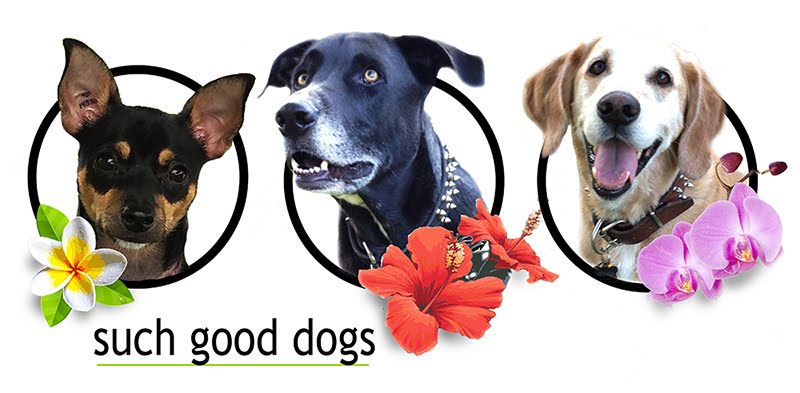Everyone needs a cool costume for Halloween...why not your dog too?
Friday, October 30, 2009
Monday, October 19, 2009
Types of Reinforcement
There are two types of reinforcement:
1) Unconditioned reinforcement
2) Conditioned reinforcement
An unconditioned reinforcer, or primary reinforcer, is something that is necessary for the dog's survival, or something the dog very much likes, and therefore, the dog does not need to learn that this thing is rewarding. Not each unconditioned reinforcer will have the same value for each dog. Some examples of unconditioned reinforcement include: food, air, water, shelter, toys, praise, and petting. The dog (NOT the owner or trainer) determines what their unconditioned reinforcers are.
A conditioned reinforcer, or secondary reinforcer, is something that does not inherently mean anything to the dog. The dog learns to associate the conditioned reinforcer as a good thing. Some examples of conditioned reinforcers include: walks, food bag noise, toys, "good" or "yes," the sound of a clicker, and the doorbell. The best example of teaching a dog a conditioned reinforcer is using the "good" or "yes" cue to mark behavior. Using this cue at the instant your dog performs a desired behavior increases the communication between human and dog. The dog learns to make a positive association between your marker word (good or yes) and a food reward.
1) Unconditioned reinforcement
2) Conditioned reinforcement
An unconditioned reinforcer, or primary reinforcer, is something that is necessary for the dog's survival, or something the dog very much likes, and therefore, the dog does not need to learn that this thing is rewarding. Not each unconditioned reinforcer will have the same value for each dog. Some examples of unconditioned reinforcement include: food, air, water, shelter, toys, praise, and petting. The dog (NOT the owner or trainer) determines what their unconditioned reinforcers are.
A conditioned reinforcer, or secondary reinforcer, is something that does not inherently mean anything to the dog. The dog learns to associate the conditioned reinforcer as a good thing. Some examples of conditioned reinforcers include: walks, food bag noise, toys, "good" or "yes," the sound of a clicker, and the doorbell. The best example of teaching a dog a conditioned reinforcer is using the "good" or "yes" cue to mark behavior. Using this cue at the instant your dog performs a desired behavior increases the communication between human and dog. The dog learns to make a positive association between your marker word (good or yes) and a food reward.
Friday, October 2, 2009
Breed of the Month--Collie
Collie
There are two types of Collies: Rough coat Collie, and Smooth coat Collie
Color: Tricolor, sable and white, blue merle and white, may have tan or white markings.
Height: Males: 22-26 inches/ Females: 20-24 inches
Weight: Males: 45-75 lbs/ Females: 40-65 lbs
Life Span: 14-16 years
Breed Health Concerns: hip dysplasia, progressive retinal atrophy, eye anomaly, and dermatomyositis.
Coat: Collie, Rough: Double coat with a furry, soft undercoat, and straight, harsh outer coat.
Coat: Collie, Smooth: Double coat with a furry, soft, dense undercoat, and a flat, hard, short outercoat.
Country of Origin: Great Britain
Visit the American Kennel Club for breed standards and more information.
Both the Smooth and Rough Collie have the same breed history and the same current breed standard. The Collie comes from centuries of of guarding and herding dogs that worked hard for their masters. Most people think of the fluffier Rough coat Collie when you mention the breed's name. The breed was made even more popular by the famous dog, Lassie, in 1954.
Their noble and intelligent nature makes both types of Collies excellent pets for families that will be loyal and fair to their dog, and never use harsh punishments. The Collie is known to be very loyal.
Exercise
The Collie requires plenty of daily exercise and enjoys going for long distances.
Grooming
Both the Smooth and Rough Collie require a good amount of grooming. Regular brushing is necessary, and in Rough coats, you must be aware of problem matts forming in the long fur. The Collie is a seasonal heavy shedder.
Training
If you approach training a Collie in a respectful and positive way, this breed is a joy to train. Collie's must be socialized from puppies to avoid them developing a shyness in the future. The Collie will greatly excel in activities such as agility, herding, obedience, and therapy.
Rough coat Collie
Smooth coat Collie (above & below)
Subscribe to:
Posts (Atom)







